 One of his tutors, Henry Tonks argued that Spencer had the most original mind of any student he had the pleasure of teaching. At the Slade he won the Composition Prize with his painting The Nativity (1912).
One of his tutors, Henry Tonks argued that Spencer had the most original mind of any student he had the pleasure of teaching. At the Slade he won the Composition Prize with his painting The Nativity (1912).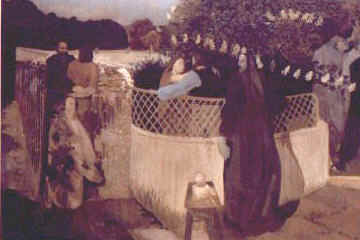 However, as his biographer, Fiona MacCarthy, points out: "His four years at the Slade were not altogether happy. He was marked out as a misfit by his physical appearance: his diminutiveness (he was only 5 feet 2 inches),
However, as his biographer, Fiona MacCarthy, points out: "His four years at the Slade were not altogether happy. He was marked out as a misfit by his physical appearance: his diminutiveness (he was only 5 feet 2 inches), his heavy fringe, and pudding-basin haircut. His aura of other-worldliness was enhanced by the fact that he commuted daily by train
his heavy fringe, and pudding-basin haircut. His aura of other-worldliness was enhanced by the fact that he commuted daily by train  from Berkshire. He was known jeeringly as Cookham, and terrified by being put upside-down in a sack."
from Berkshire. He was known jeeringly as Cookham, and terrified by being put upside-down in a sack." Sir Stanley Spencer painted Cookham He painted its scruffy backyards, its messy bedrooms, its humble gardens. He developed a way of intensifying the visual power of everyday
Sir Stanley Spencer painted Cookham He painted its scruffy backyards, its messy bedrooms, its humble gardens. He developed a way of intensifying the visual power of everyday 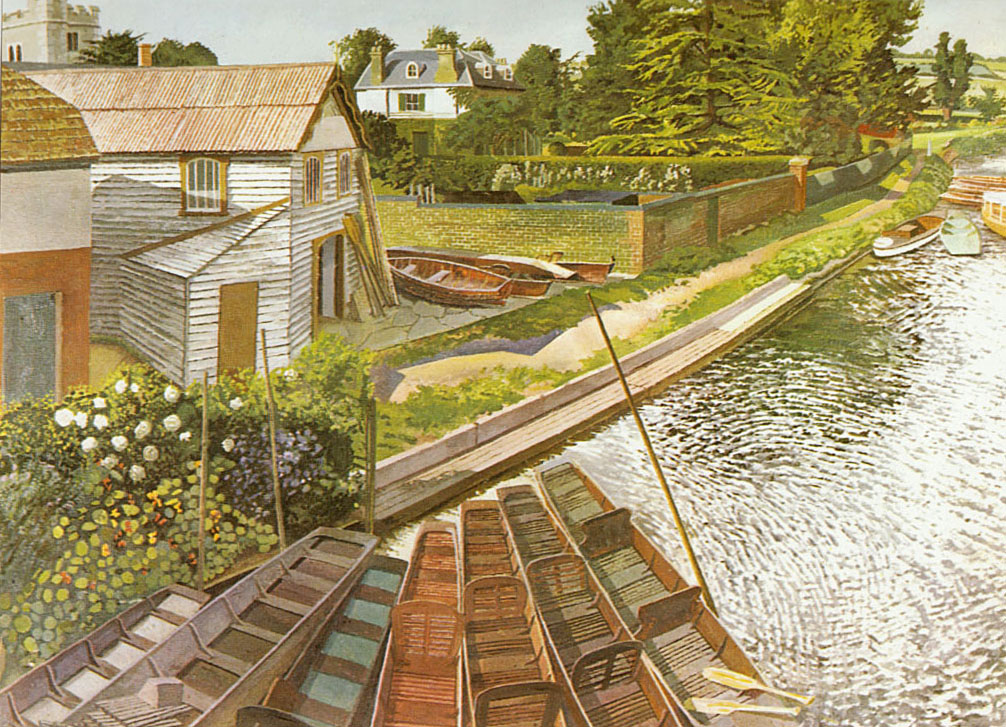 subjects, as if to say:
subjects, as if to say:  You might think all this ordinary; I consider it sacred. (30 June 1891 – 14 December 1959) he was an English painter of great skill obssessed with pussy and why not
You might think all this ordinary; I consider it sacred. (30 June 1891 – 14 December 1959) he was an English painter of great skill obssessed with pussy and why not The Cookham Resurrection, or in its full title, The Resurrection in Cookham Churchyard, is one of the greatest of twentieth century English paintings, and in some opinions, the greatest. It offers so many levels of meaning that it can be considered a poem in paint. If it seems odd to speak of a painting as a poem, the parallel is justified in that both can source from
The Cookham Resurrection, or in its full title, The Resurrection in Cookham Churchyard, is one of the greatest of twentieth century English paintings, and in some opinions, the greatest. It offers so many levels of meaning that it can be considered a poem in paint. If it seems odd to speak of a painting as a poem, the parallel is justified in that both can source from  comparable emotions.For Spencer, loving God and loving women expressed the same impulse: Sex was a sacrament. "A man raises a woman's dress with the same passionate admiration and love for the woman as the priest raises the host to the altar," he wrote. But this part of Spencer's life went badly. Like D.H. Lawrence, he was a prophet of Eros whose own erotic life was miserable.. Much of his work depicts Biblical scenes, from miraclesto Crucifixion,
comparable emotions.For Spencer, loving God and loving women expressed the same impulse: Sex was a sacrament. "A man raises a woman's dress with the same passionate admiration and love for the woman as the priest raises the host to the altar," he wrote. But this part of Spencer's life went badly. Like D.H. Lawrence, he was a prophet of Eros whose own erotic life was miserable.. Much of his work depicts Biblical scenes, from miraclesto Crucifixion,  happening not in the Holy Land but in the small Thames-side village where he was born and spent most of his life. He referred to Cookham as "a village in Heaven." One of the startling images is Swan Upping at Cookham,
happening not in the Holy Land but in the small Thames-side village where he was born and spent most of his life. He referred to Cookham as "a village in Heaven." One of the startling images is Swan Upping at Cookham, 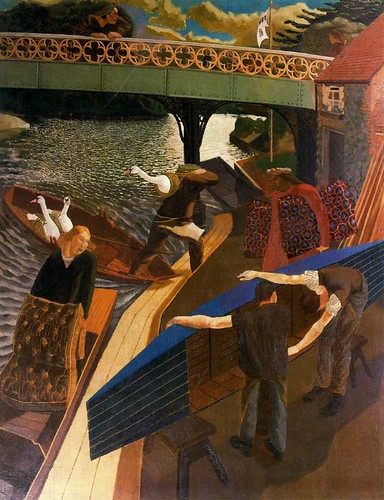 finished in 1919, looks at first glance like a surrealist dream but turns out to be grounded in fact. At Cookham every year, they gathered and tagged the Thames swans, and Spencer depicted his fellow villagers jerking swans out of the water and bringing them to shore, the people and birds all crowded together on the canvas.
finished in 1919, looks at first glance like a surrealist dream but turns out to be grounded in fact. At Cookham every year, they gathered and tagged the Thames swans, and Spencer depicted his fellow villagers jerking swans out of the water and bringing them to shore, the people and birds all crowded together on the canvas. Fellow-villagers frequently stand in for their Gospel counterparts, lending Christian teachings an eerie immediacy.
Fellow-villagers frequently stand in for their Gospel counterparts, lending Christian teachings an eerie immediacy.
Spencer was born and spent much of his life in Cookham in Berkshire. His father, William Spencer, was a music teacher. His younger brother, Gilbert Spencer (1892–1979), was a painter of landscapes.
His father, William Spencer, was a music teacher. His younger brother, Gilbert Spencer (1892–1979), was a painter of landscapes.
 His father, William Spencer, was a music teacher. His younger brother, Gilbert Spencer (1892–1979), was a painter of landscapes.
His father, William Spencer, was a music teacher. His younger brother, Gilbert Spencer (1892–1979), was a painter of landscapes.
From 1908 to 1912, Spencer studied at the Slade School of Art at University College, London under Henry Tonks and others. His contemporaries at the Slade included Dora Carrington,
and others. His contemporaries at the Slade included Dora Carrington,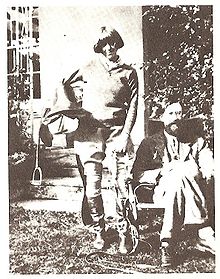 Mark Gertler,
Mark Gertler, Paul Nash,
Paul Nash, Edward Wadsworth,
Edward Wadsworth, Isaac Rosenberg
Isaac Rosenberg and David Bomberg.
and David Bomberg. So profound was his attachment to the village of his birth that most days he would take the train back home in time for tea. It even became his nickname: his fellow student C.R.W. Nevinson
So profound was his attachment to the village of his birth that most days he would take the train back home in time for tea. It even became his nickname: his fellow student C.R.W. Nevinson  dubbed him Cookham, a name which Spencer himself took to using for a time.(below Gertler painting)
dubbed him Cookham, a name which Spencer himself took to using for a time.(below Gertler painting)
 and others. His contemporaries at the Slade included Dora Carrington,
and others. His contemporaries at the Slade included Dora Carrington, Mark Gertler,
Mark Gertler, Paul Nash,
Paul Nash, Edward Wadsworth,
Edward Wadsworth, Isaac Rosenberg
Isaac Rosenberg and David Bomberg.
and David Bomberg. So profound was his attachment to the village of his birth that most days he would take the train back home in time for tea. It even became his nickname: his fellow student C.R.W. Nevinson
So profound was his attachment to the village of his birth that most days he would take the train back home in time for tea. It even became his nickname: his fellow student C.R.W. Nevinson  dubbed him Cookham, a name which Spencer himself took to using for a time.(below Gertler painting)
dubbed him Cookham, a name which Spencer himself took to using for a time.(below Gertler painting)]
After a long period of agonising whether or not to join up, in 1915 Spencer volunteered to serve with theRoyal Army Medical Corps and worked as an orderly at the Beaufort War Hospital (which later became Glenside)
Medical Corps and worked as an orderly at the Beaufort War Hospital (which later became Glenside) .In 1916, the 24-year-old Spencer volunteered for service with the RAMC in Macedonia, and served with the 68th Field Ambulance unit. He subsequently volunteered to be transferred to the Berkshire Regiment. His survival of the devastation and torment that killed so many of his fellows indelibly marked Spencer's attitude to life and death. Such preoccupations come through time and again in his religious works.
.In 1916, the 24-year-old Spencer volunteered for service with the RAMC in Macedonia, and served with the 68th Field Ambulance unit. He subsequently volunteered to be transferred to the Berkshire Regiment. His survival of the devastation and torment that killed so many of his fellows indelibly marked Spencer's attitude to life and death. Such preoccupations come through time and again in his religious works.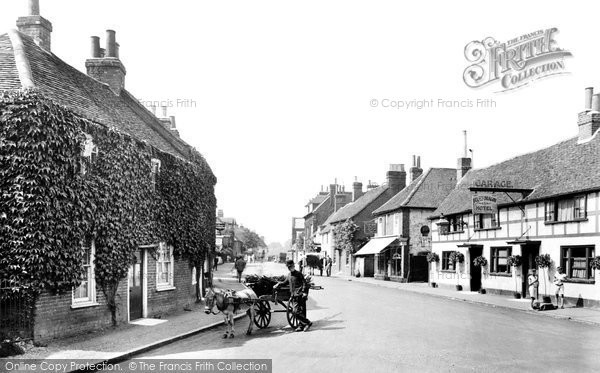
 Medical Corps and worked as an orderly at the Beaufort War Hospital (which later became Glenside)
Medical Corps and worked as an orderly at the Beaufort War Hospital (which later became Glenside) .In 1916, the 24-year-old Spencer volunteered for service with the RAMC in Macedonia, and served with the 68th Field Ambulance unit. He subsequently volunteered to be transferred to the Berkshire Regiment. His survival of the devastation and torment that killed so many of his fellows indelibly marked Spencer's attitude to life and death. Such preoccupations come through time and again in his religious works.
.In 1916, the 24-year-old Spencer volunteered for service with the RAMC in Macedonia, and served with the 68th Field Ambulance unit. He subsequently volunteered to be transferred to the Berkshire Regiment. His survival of the devastation and torment that killed so many of his fellows indelibly marked Spencer's attitude to life and death. Such preoccupations come through time and again in his religious works.
Towards the end of the war he was commissioned by the War Artists Advisory Committee to paint what became Travoys Arriving with Wounded at a Dressing Station at Smol, Macedonia, September 1916 (now in the Imperial War Museum). It was visibly the consequence of Spencer's experience in the medical corps. A further major commission was to paint murals for the Sandham Memorial Chapel in Burghclere dedicated to the war dead. The altarpiece depicts the Resurrection of the Soldiers.he wrote to his friend, Henry Lamb:
(now in the Imperial War Museum). It was visibly the consequence of Spencer's experience in the medical corps. A further major commission was to paint murals for the Sandham Memorial Chapel in Burghclere dedicated to the war dead. The altarpiece depicts the Resurrection of the Soldiers.he wrote to his friend, Henry Lamb:  "Two hundred patients or more would arrive in the middle of the night - this was disquieting and disturbing. One had just got used to the patients one had; had mentally and imaginatively visualized them. I have to move patients with their beds from one ward to another or perhaps to the theatre."
"Two hundred patients or more would arrive in the middle of the night - this was disquieting and disturbing. One had just got used to the patients one had; had mentally and imaginatively visualized them. I have to move patients with their beds from one ward to another or perhaps to the theatre."
 (now in the Imperial War Museum). It was visibly the consequence of Spencer's experience in the medical corps. A further major commission was to paint murals for the Sandham Memorial Chapel in Burghclere dedicated to the war dead. The altarpiece depicts the Resurrection of the Soldiers.he wrote to his friend, Henry Lamb:
(now in the Imperial War Museum). It was visibly the consequence of Spencer's experience in the medical corps. A further major commission was to paint murals for the Sandham Memorial Chapel in Burghclere dedicated to the war dead. The altarpiece depicts the Resurrection of the Soldiers.he wrote to his friend, Henry Lamb:  "Two hundred patients or more would arrive in the middle of the night - this was disquieting and disturbing. One had just got used to the patients one had; had mentally and imaginatively visualized them. I have to move patients with their beds from one ward to another or perhaps to the theatre."
"Two hundred patients or more would arrive in the middle of the night - this was disquieting and disturbing. One had just got used to the patients one had; had mentally and imaginatively visualized them. I have to move patients with their beds from one ward to another or perhaps to the theatre." In August 1916 he was sent as part of the 68th Field Ambulance unit to Salonika, a port being defended by General Maurice Sarrail and 150,000, British and French soldiers. In August 1917 he volunteered for the infantry, joining the 7th battalion, the Royal Berkshires, and spending several months in the front line. He later recalled: "Our activities consisted of outpost duty and patrolling the wire at night and during the daytime doing odd fatigues, just outside our dugouts. In the evening just before sunset, the Bulgars started a barrage. The shells dropped uncomfortably near and I was glad when getting into the outposts, we were able to take cover in a communication trench."
and 150,000, British and French soldiers. In August 1917 he volunteered for the infantry, joining the 7th battalion, the Royal Berkshires, and spending several months in the front line. He later recalled: "Our activities consisted of outpost duty and patrolling the wire at night and during the daytime doing odd fatigues, just outside our dugouts. In the evening just before sunset, the Bulgars started a barrage. The shells dropped uncomfortably near and I was glad when getting into the outposts, we were able to take cover in a communication trench."
On one occasion he went out on patrol with one of the officers: "I went out with a captain and he was hit and sank to the ground. His hand went up to his neck and I saw a gaping bullet wound in it. I bandaged the wound the best I could and called for stretcher-bearers. I helped to support the captain, who was paralyzed." Spencer was  devastated when he heard him whisper to another officer: "Understand, Spencer is not a fool; he is a damned good man." Spencer was shocked by what he heard: "What's all this? Who has been saying otherwise?"Despite Stanley's early resolve to curb his normal male instincts in the cause of art, he had on his return from the Great War become interested in a dentist's daughter called Nancy, from Reading, and she in him, a budding romance ended abruptly by her disapproving father. But long before the War, Stanley and Gilbert had become boyishly attracted to two daughters of a Cookham master-butcher by the name of Worster, celebrated in the locality for his excellent sausages and chronicled in Stanley's painting, The Sausage Shop, 1951. Both girls were contemporaneous pupils at the Spencer family dame-school. Stanley formed an attachment to the elder, Dorothy ('Dot'), making little drawings on scraps of paper for her which she kept all her life. Gilbert favoured the younger, Emily. Dorothy acted as the model for Stanley's early drawing of The Fairy on the Waterlily Leaf, and both girls appear in his pre-war painting Two Girls and a Beehive, in which Dorothy has the same long fair hair as the girl here and shows similar facial features.After a finishing school in Folkestone, Dorothy returned to Cookham and presently married Eddie Remington, a racing driver and motor engineer who owned a garage in the High Street. Stanley enjoyed calling on them in later years, often dropping in for tea, and in 1929 bought his first (and only) car from them (Emily became a nurse in the Great War and married an Australian soldier, emigrating to be with him.) Aphotograph shows Stanley and his new car outside Remington's Garage in Cookham. On his right Jas Wood is correctly dressed, even to the gloves, for teaching Stanley to drive (no driving test then.) Hilda sits on the battery box, daughter Shirin balances on the running board, while Hilda's mother, Annie Carline, keeps a watchful eye on her. Stanley was never a confident driver, and after a minor collision with a lorry in Maidenhead, preferred Hilda to drive. She thoroughly enjoyed it. On his return in 1919 he and Gilbert were introduced to all the Carlines, a cultured, lively and artistic family from Oxford who had settled in London in a comfortable house in Downshire Hill in Hampstead. Hilda, the only daughter, was also a trained painter, and both Gilbert and Stanley were attracted to her (as had been others, but she had refused their proposals of marriage.) As things turned out, it was Stanley in whom she became interested and wanted to marry. The feelings she raised in him - she has wonderful thoughts - became so powerful that, for him, only a Resurrection theme could do justice to them. Where else could he set his new picture but in the Cookham of his Cookham-feelings, the boyhood village which was such a creative home for him : and where else in the village could he locate it but at its ancient churchyard, where, the previous year, he and Gilbert had walked a desolate Pa after Ma's funeral, trying to distract him by persuading him to tell tales of the former villagers occupying the graves there?One of the advantages in deconstructing Stanley's paintings through his own words is the glimpse they offer of the significance he attached to what he called his Cookham-feelings.As a child, Stanley was taught the names of plants and trees by his elder sisters on afternoon walks. As a boy, his older brothers told the tale of the birds round Cookham. In the summers, he swam with companions in the Thames and explored its hay-meadows, flooded in winter, but richly grassed and wild-flowered in summer, so that the marsh meadows, full of flowers, left me with an aching longng, and in my art that longing was among the first I sought to satisfy. Blend these experiences of nature with those from a happy and protected (cosy) home life at Fernlea, from his mother's chapel-going and bible reading, from his father's church organ-playing and advocacy of Ruskin, from his siblings' daily music making, from his adolescent access to a family library which ranged from Dante to Milton, and from the Metaphysical Poets to the The Golden Bough, and the heady brew is distilled which Stanley called his Cookham feelings. We swim and look at the bank over the rushes. I swim right in the pathway of sunlight. I go home to breakfast thinking as I go of the beautiful wholeness of the day. During the morning I am visited, and walk about being in that visitation. Now everything seems more definite and to put on a new meaning and freshness. In the afternoon I set out my work and begin my picture. I leave off at dusk, fully delighted with the spiritual labour I have done. It is little wonder that in adolescent days, Cookham came to embody for Stanley the Paradise he saw reflected in Early Italian paintings. Stanley's concept of the meaning of Paradise is most clearly evidenced in the succession of Resurrection paintings he undertook. It is tempting to interpret them as imagined Resurrections, as though he were himself a medieval artist dutifully making an inspired guess at what the event might look like. But this website constantly argues that he did not use that inventive kind of imagination in making his pictures. He always started with the basic facts of his experience. If it can be accepted that the Resurrections he depicted are not literal representations of the Christian event as such - in other words they are not occurring after the physical death of the participants - then we can conclude that his scenes were intended to take place during the lives of the figures shown and of Stanley himself as the artist who fashioned them. He was deriving from his concept special meanings - that is, universal meanings, but inevitably expressed in termsIf this notion is developed, it can be seen to imply that in Stanley’s thinking, heaven must exist concomitantly with our physical experience, and can be reached while we live. We get to it in those mysterious moments when we feel ourselves to be in synchronicity with the universe. In those moments we experience a calmness of the spirit, a peace he called happiness. On each such occasion we achieve a moment ofperfection, that is, we come briefly into our universal identity. The occasions join up to comprise our up-in-heaven life.
devastated when he heard him whisper to another officer: "Understand, Spencer is not a fool; he is a damned good man." Spencer was shocked by what he heard: "What's all this? Who has been saying otherwise?"Despite Stanley's early resolve to curb his normal male instincts in the cause of art, he had on his return from the Great War become interested in a dentist's daughter called Nancy, from Reading, and she in him, a budding romance ended abruptly by her disapproving father. But long before the War, Stanley and Gilbert had become boyishly attracted to two daughters of a Cookham master-butcher by the name of Worster, celebrated in the locality for his excellent sausages and chronicled in Stanley's painting, The Sausage Shop, 1951. Both girls were contemporaneous pupils at the Spencer family dame-school. Stanley formed an attachment to the elder, Dorothy ('Dot'), making little drawings on scraps of paper for her which she kept all her life. Gilbert favoured the younger, Emily. Dorothy acted as the model for Stanley's early drawing of The Fairy on the Waterlily Leaf, and both girls appear in his pre-war painting Two Girls and a Beehive, in which Dorothy has the same long fair hair as the girl here and shows similar facial features.After a finishing school in Folkestone, Dorothy returned to Cookham and presently married Eddie Remington, a racing driver and motor engineer who owned a garage in the High Street. Stanley enjoyed calling on them in later years, often dropping in for tea, and in 1929 bought his first (and only) car from them (Emily became a nurse in the Great War and married an Australian soldier, emigrating to be with him.) Aphotograph shows Stanley and his new car outside Remington's Garage in Cookham. On his right Jas Wood is correctly dressed, even to the gloves, for teaching Stanley to drive (no driving test then.) Hilda sits on the battery box, daughter Shirin balances on the running board, while Hilda's mother, Annie Carline, keeps a watchful eye on her. Stanley was never a confident driver, and after a minor collision with a lorry in Maidenhead, preferred Hilda to drive. She thoroughly enjoyed it. On his return in 1919 he and Gilbert were introduced to all the Carlines, a cultured, lively and artistic family from Oxford who had settled in London in a comfortable house in Downshire Hill in Hampstead. Hilda, the only daughter, was also a trained painter, and both Gilbert and Stanley were attracted to her (as had been others, but she had refused their proposals of marriage.) As things turned out, it was Stanley in whom she became interested and wanted to marry. The feelings she raised in him - she has wonderful thoughts - became so powerful that, for him, only a Resurrection theme could do justice to them. Where else could he set his new picture but in the Cookham of his Cookham-feelings, the boyhood village which was such a creative home for him : and where else in the village could he locate it but at its ancient churchyard, where, the previous year, he and Gilbert had walked a desolate Pa after Ma's funeral, trying to distract him by persuading him to tell tales of the former villagers occupying the graves there?One of the advantages in deconstructing Stanley's paintings through his own words is the glimpse they offer of the significance he attached to what he called his Cookham-feelings.As a child, Stanley was taught the names of plants and trees by his elder sisters on afternoon walks. As a boy, his older brothers told the tale of the birds round Cookham. In the summers, he swam with companions in the Thames and explored its hay-meadows, flooded in winter, but richly grassed and wild-flowered in summer, so that the marsh meadows, full of flowers, left me with an aching longng, and in my art that longing was among the first I sought to satisfy. Blend these experiences of nature with those from a happy and protected (cosy) home life at Fernlea, from his mother's chapel-going and bible reading, from his father's church organ-playing and advocacy of Ruskin, from his siblings' daily music making, from his adolescent access to a family library which ranged from Dante to Milton, and from the Metaphysical Poets to the The Golden Bough, and the heady brew is distilled which Stanley called his Cookham feelings. We swim and look at the bank over the rushes. I swim right in the pathway of sunlight. I go home to breakfast thinking as I go of the beautiful wholeness of the day. During the morning I am visited, and walk about being in that visitation. Now everything seems more definite and to put on a new meaning and freshness. In the afternoon I set out my work and begin my picture. I leave off at dusk, fully delighted with the spiritual labour I have done. It is little wonder that in adolescent days, Cookham came to embody for Stanley the Paradise he saw reflected in Early Italian paintings. Stanley's concept of the meaning of Paradise is most clearly evidenced in the succession of Resurrection paintings he undertook. It is tempting to interpret them as imagined Resurrections, as though he were himself a medieval artist dutifully making an inspired guess at what the event might look like. But this website constantly argues that he did not use that inventive kind of imagination in making his pictures. He always started with the basic facts of his experience. If it can be accepted that the Resurrections he depicted are not literal representations of the Christian event as such - in other words they are not occurring after the physical death of the participants - then we can conclude that his scenes were intended to take place during the lives of the figures shown and of Stanley himself as the artist who fashioned them. He was deriving from his concept special meanings - that is, universal meanings, but inevitably expressed in termsIf this notion is developed, it can be seen to imply that in Stanley’s thinking, heaven must exist concomitantly with our physical experience, and can be reached while we live. We get to it in those mysterious moments when we feel ourselves to be in synchronicity with the universe. In those moments we experience a calmness of the spirit, a peace he called happiness. On each such occasion we achieve a moment ofperfection, that is, we come briefly into our universal identity. The occasions join up to comprise our up-in-heaven life.
 devastated when he heard him whisper to another officer: "Understand, Spencer is not a fool; he is a damned good man." Spencer was shocked by what he heard: "What's all this? Who has been saying otherwise?"Despite Stanley's early resolve to curb his normal male instincts in the cause of art, he had on his return from the Great War become interested in a dentist's daughter called Nancy, from Reading, and she in him, a budding romance ended abruptly by her disapproving father. But long before the War, Stanley and Gilbert had become boyishly attracted to two daughters of a Cookham master-butcher by the name of Worster, celebrated in the locality for his excellent sausages and chronicled in Stanley's painting, The Sausage Shop, 1951. Both girls were contemporaneous pupils at the Spencer family dame-school. Stanley formed an attachment to the elder, Dorothy ('Dot'), making little drawings on scraps of paper for her which she kept all her life. Gilbert favoured the younger, Emily. Dorothy acted as the model for Stanley's early drawing of The Fairy on the Waterlily Leaf, and both girls appear in his pre-war painting Two Girls and a Beehive, in which Dorothy has the same long fair hair as the girl here and shows similar facial features.After a finishing school in Folkestone, Dorothy returned to Cookham and presently married Eddie Remington, a racing driver and motor engineer who owned a garage in the High Street. Stanley enjoyed calling on them in later years, often dropping in for tea, and in 1929 bought his first (and only) car from them (Emily became a nurse in the Great War and married an Australian soldier, emigrating to be with him.) Aphotograph shows Stanley and his new car outside Remington's Garage in Cookham. On his right Jas Wood is correctly dressed, even to the gloves, for teaching Stanley to drive (no driving test then.) Hilda sits on the battery box, daughter Shirin balances on the running board, while Hilda's mother, Annie Carline, keeps a watchful eye on her. Stanley was never a confident driver, and after a minor collision with a lorry in Maidenhead, preferred Hilda to drive. She thoroughly enjoyed it. On his return in 1919 he and Gilbert were introduced to all the Carlines, a cultured, lively and artistic family from Oxford who had settled in London in a comfortable house in Downshire Hill in Hampstead. Hilda, the only daughter, was also a trained painter, and both Gilbert and Stanley were attracted to her (as had been others, but she had refused their proposals of marriage.) As things turned out, it was Stanley in whom she became interested and wanted to marry. The feelings she raised in him - she has wonderful thoughts - became so powerful that, for him, only a Resurrection theme could do justice to them. Where else could he set his new picture but in the Cookham of his Cookham-feelings, the boyhood village which was such a creative home for him : and where else in the village could he locate it but at its ancient churchyard, where, the previous year, he and Gilbert had walked a desolate Pa after Ma's funeral, trying to distract him by persuading him to tell tales of the former villagers occupying the graves there?One of the advantages in deconstructing Stanley's paintings through his own words is the glimpse they offer of the significance he attached to what he called his Cookham-feelings.As a child, Stanley was taught the names of plants and trees by his elder sisters on afternoon walks. As a boy, his older brothers told the tale of the birds round Cookham. In the summers, he swam with companions in the Thames and explored its hay-meadows, flooded in winter, but richly grassed and wild-flowered in summer, so that the marsh meadows, full of flowers, left me with an aching longng, and in my art that longing was among the first I sought to satisfy. Blend these experiences of nature with those from a happy and protected (cosy) home life at Fernlea, from his mother's chapel-going and bible reading, from his father's church organ-playing and advocacy of Ruskin, from his siblings' daily music making, from his adolescent access to a family library which ranged from Dante to Milton, and from the Metaphysical Poets to the The Golden Bough, and the heady brew is distilled which Stanley called his Cookham feelings. We swim and look at the bank over the rushes. I swim right in the pathway of sunlight. I go home to breakfast thinking as I go of the beautiful wholeness of the day. During the morning I am visited, and walk about being in that visitation. Now everything seems more definite and to put on a new meaning and freshness. In the afternoon I set out my work and begin my picture. I leave off at dusk, fully delighted with the spiritual labour I have done. It is little wonder that in adolescent days, Cookham came to embody for Stanley the Paradise he saw reflected in Early Italian paintings. Stanley's concept of the meaning of Paradise is most clearly evidenced in the succession of Resurrection paintings he undertook. It is tempting to interpret them as imagined Resurrections, as though he were himself a medieval artist dutifully making an inspired guess at what the event might look like. But this website constantly argues that he did not use that inventive kind of imagination in making his pictures. He always started with the basic facts of his experience. If it can be accepted that the Resurrections he depicted are not literal representations of the Christian event as such - in other words they are not occurring after the physical death of the participants - then we can conclude that his scenes were intended to take place during the lives of the figures shown and of Stanley himself as the artist who fashioned them. He was deriving from his concept special meanings - that is, universal meanings, but inevitably expressed in termsIf this notion is developed, it can be seen to imply that in Stanley’s thinking, heaven must exist concomitantly with our physical experience, and can be reached while we live. We get to it in those mysterious moments when we feel ourselves to be in synchronicity with the universe. In those moments we experience a calmness of the spirit, a peace he called happiness. On each such occasion we achieve a moment ofperfection, that is, we come briefly into our universal identity. The occasions join up to comprise our up-in-heaven life.
devastated when he heard him whisper to another officer: "Understand, Spencer is not a fool; he is a damned good man." Spencer was shocked by what he heard: "What's all this? Who has been saying otherwise?"Despite Stanley's early resolve to curb his normal male instincts in the cause of art, he had on his return from the Great War become interested in a dentist's daughter called Nancy, from Reading, and she in him, a budding romance ended abruptly by her disapproving father. But long before the War, Stanley and Gilbert had become boyishly attracted to two daughters of a Cookham master-butcher by the name of Worster, celebrated in the locality for his excellent sausages and chronicled in Stanley's painting, The Sausage Shop, 1951. Both girls were contemporaneous pupils at the Spencer family dame-school. Stanley formed an attachment to the elder, Dorothy ('Dot'), making little drawings on scraps of paper for her which she kept all her life. Gilbert favoured the younger, Emily. Dorothy acted as the model for Stanley's early drawing of The Fairy on the Waterlily Leaf, and both girls appear in his pre-war painting Two Girls and a Beehive, in which Dorothy has the same long fair hair as the girl here and shows similar facial features.After a finishing school in Folkestone, Dorothy returned to Cookham and presently married Eddie Remington, a racing driver and motor engineer who owned a garage in the High Street. Stanley enjoyed calling on them in later years, often dropping in for tea, and in 1929 bought his first (and only) car from them (Emily became a nurse in the Great War and married an Australian soldier, emigrating to be with him.) Aphotograph shows Stanley and his new car outside Remington's Garage in Cookham. On his right Jas Wood is correctly dressed, even to the gloves, for teaching Stanley to drive (no driving test then.) Hilda sits on the battery box, daughter Shirin balances on the running board, while Hilda's mother, Annie Carline, keeps a watchful eye on her. Stanley was never a confident driver, and after a minor collision with a lorry in Maidenhead, preferred Hilda to drive. She thoroughly enjoyed it. On his return in 1919 he and Gilbert were introduced to all the Carlines, a cultured, lively and artistic family from Oxford who had settled in London in a comfortable house in Downshire Hill in Hampstead. Hilda, the only daughter, was also a trained painter, and both Gilbert and Stanley were attracted to her (as had been others, but she had refused their proposals of marriage.) As things turned out, it was Stanley in whom she became interested and wanted to marry. The feelings she raised in him - she has wonderful thoughts - became so powerful that, for him, only a Resurrection theme could do justice to them. Where else could he set his new picture but in the Cookham of his Cookham-feelings, the boyhood village which was such a creative home for him : and where else in the village could he locate it but at its ancient churchyard, where, the previous year, he and Gilbert had walked a desolate Pa after Ma's funeral, trying to distract him by persuading him to tell tales of the former villagers occupying the graves there?One of the advantages in deconstructing Stanley's paintings through his own words is the glimpse they offer of the significance he attached to what he called his Cookham-feelings.As a child, Stanley was taught the names of plants and trees by his elder sisters on afternoon walks. As a boy, his older brothers told the tale of the birds round Cookham. In the summers, he swam with companions in the Thames and explored its hay-meadows, flooded in winter, but richly grassed and wild-flowered in summer, so that the marsh meadows, full of flowers, left me with an aching longng, and in my art that longing was among the first I sought to satisfy. Blend these experiences of nature with those from a happy and protected (cosy) home life at Fernlea, from his mother's chapel-going and bible reading, from his father's church organ-playing and advocacy of Ruskin, from his siblings' daily music making, from his adolescent access to a family library which ranged from Dante to Milton, and from the Metaphysical Poets to the The Golden Bough, and the heady brew is distilled which Stanley called his Cookham feelings. We swim and look at the bank over the rushes. I swim right in the pathway of sunlight. I go home to breakfast thinking as I go of the beautiful wholeness of the day. During the morning I am visited, and walk about being in that visitation. Now everything seems more definite and to put on a new meaning and freshness. In the afternoon I set out my work and begin my picture. I leave off at dusk, fully delighted with the spiritual labour I have done. It is little wonder that in adolescent days, Cookham came to embody for Stanley the Paradise he saw reflected in Early Italian paintings. Stanley's concept of the meaning of Paradise is most clearly evidenced in the succession of Resurrection paintings he undertook. It is tempting to interpret them as imagined Resurrections, as though he were himself a medieval artist dutifully making an inspired guess at what the event might look like. But this website constantly argues that he did not use that inventive kind of imagination in making his pictures. He always started with the basic facts of his experience. If it can be accepted that the Resurrections he depicted are not literal representations of the Christian event as such - in other words they are not occurring after the physical death of the participants - then we can conclude that his scenes were intended to take place during the lives of the figures shown and of Stanley himself as the artist who fashioned them. He was deriving from his concept special meanings - that is, universal meanings, but inevitably expressed in termsIf this notion is developed, it can be seen to imply that in Stanley’s thinking, heaven must exist concomitantly with our physical experience, and can be reached while we live. We get to it in those mysterious moments when we feel ourselves to be in synchronicity with the universe. In those moments we experience a calmness of the spirit, a peace he called happiness. On each such occasion we achieve a moment ofperfection, that is, we come briefly into our universal identity. The occasions join up to comprise our up-in-heaven life. individual to himself.
Stanley Spencer painted The Resurrection, between 1924 and 1926 in a studio in Hampstead borrowed from Henry Lamb. When it was showed for the first time in February 1927 The Times critic described it as "the most important picture painted by any English artist in the present century… It is as if a Pre-Raphaelite had shaken hands with a Cubist". The painting was purchased by Joseph Duveen who then gave it to the Tate Gallery.To paint his picture, Stanley took over Henry Lamb's former studio on an upper floor of the Vale of Health Hotel
who then gave it to the Tate Gallery.To paint his picture, Stanley took over Henry Lamb's former studio on an upper floor of the Vale of Health Hotel (Spencer House now) in a hollow of Hampstead Heath, the Behrends
(Spencer House now) in a hollow of Hampstead Heath, the Behrends  subsidising his rent in the meantime. As the studio was only a short walk from Downshire Hill, the Carlines initially offered him lodging.
subsidising his rent in the meantime. As the studio was only a short walk from Downshire Hill, the Carlines initially offered him lodging.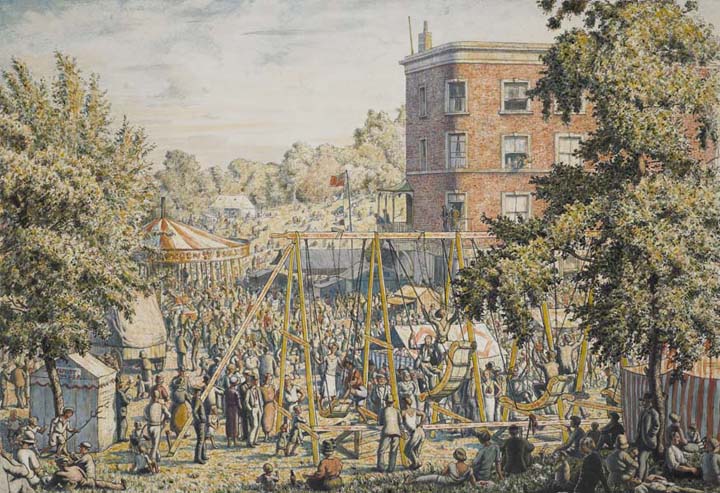 With Hilda able easily to visit him in his studio, it was inevitable that sooner or later their feelings for each other would overcome their social restraints. They first had sex there in the May of 1923. Stanley was 31, and Hilda a year older. It was Stanley's
With Hilda able easily to visit him in his studio, it was inevitable that sooner or later their feelings for each other would overcome their social restraints. They first had sex there in the May of 1923. Stanley was 31, and Hilda a year older. It was Stanley's  initiation, a revelation so intense that it confirmed Hilda as his lifelong Muse, immortal.
initiation, a revelation so intense that it confirmed Hilda as his lifelong Muse, immortal. Yet such was Stanley's indecision that almost another two years passed before they finally married, renting a second apartment in the hotel as their home.
Yet such was Stanley's indecision that almost another two years passed before they finally married, renting a second apartment in the hotel as their home.
 who then gave it to the Tate Gallery.To paint his picture, Stanley took over Henry Lamb's former studio on an upper floor of the Vale of Health Hotel
who then gave it to the Tate Gallery.To paint his picture, Stanley took over Henry Lamb's former studio on an upper floor of the Vale of Health Hotel (Spencer House now) in a hollow of Hampstead Heath, the Behrends
(Spencer House now) in a hollow of Hampstead Heath, the Behrends  subsidising his rent in the meantime. As the studio was only a short walk from Downshire Hill, the Carlines initially offered him lodging.
subsidising his rent in the meantime. As the studio was only a short walk from Downshire Hill, the Carlines initially offered him lodging. With Hilda able easily to visit him in his studio, it was inevitable that sooner or later their feelings for each other would overcome their social restraints. They first had sex there in the May of 1923. Stanley was 31, and Hilda a year older. It was Stanley's
With Hilda able easily to visit him in his studio, it was inevitable that sooner or later their feelings for each other would overcome their social restraints. They first had sex there in the May of 1923. Stanley was 31, and Hilda a year older. It was Stanley's  initiation, a revelation so intense that it confirmed Hilda as his lifelong Muse, immortal.
initiation, a revelation so intense that it confirmed Hilda as his lifelong Muse, immortal. Yet such was Stanley's indecision that almost another two years passed before they finally married, renting a second apartment in the hotel as their home.
Yet such was Stanley's indecision that almost another two years passed before they finally married, renting a second apartment in the hotel as their home.One critic argued that "Spencer believed that the divine rested in all creation. He saw his home town of Cookham as a paradise in which everything is invested with mystical significance. The local churchyard here becomes the setting for the resurrection of the dead. Christ is enthroned in the church porch, cradling three babies, with God the Father standing behind. Spencer himself appears near the centre, naked, leaning against a grave stone; his fiancée Hilda lies sleeping in a bed of ivy. At the top left, risen souls are transported to Heaven in the pleasure steamers that then ploughed the Thames."Sir Henry Slesser was an ambitious lawyer and judge who was appointed Solicitor-General in Baldwin's Labour Government of 1924. He lived across the river from Cookham, and when Stanley's family home Fernlea became overcrowded with his brothers returning from the war with their new families, he and his wife Margaret provided Stanley with a year's accommodation in Cornerways, their riverside house. Stanley was profoundly grateful and painted several pictures for their private chapel, built into the loft of their boathouse, of which the most celebrated is his 1922 version of The Last Supper.
While working on this cycle almost continuously between 1926 and 1932, Spencer lived in a cottage alongside the chapel with his wife, Hilda Carline (1889–1950) and their two daughters: Shirin (b. 1925) and Unity (b. 1930). The cultural historian, Fiona MacCarthy has argued: "The narrative of Stanley Spencer's war - the wounded arriving at Beaufort, the training camp at Tweseldown, the day-to-day routines of service in Macedonia - climaxes in the crowded, joyful central composition The Resurrection of the Soldiers covering the whole east wall. It is a highly personal sequence that transcends the anecdotal, treating the grand themes of glory and redemption in an extraordinary fusion of grandiloquence and homeliness."
After completing the Sandham Memorial Chapel Spencer and his young family moved to Lindworth, a house in Cookham. However, it was not a happy marriage and her passionate Christian Science principles seriously impaired their sex life. 

In 1939, he went on a painting holiday at the suggestion of one of his friends, William Rothenstein, to Leonard Stanley in Gloucestershire.
William Rothenstein, to Leonard Stanley in Gloucestershire. 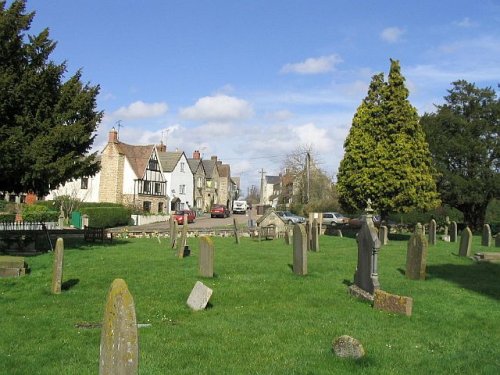 This holiday extended to two years; Stanley stayed at the White Hart Inn
This holiday extended to two years; Stanley stayed at the White Hart Inn  and created many of his important works in his room above the bar which he used as a studio, including 'Us in Gloucestershire' and 'The Wool Shop'.
and created many of his important works in his room above the bar which he used as a studio, including 'Us in Gloucestershire' and 'The Wool Shop'.
 William Rothenstein, to Leonard Stanley in Gloucestershire.
William Rothenstein, to Leonard Stanley in Gloucestershire.  This holiday extended to two years; Stanley stayed at the White Hart Inn
This holiday extended to two years; Stanley stayed at the White Hart Inn  and created many of his important works in his room above the bar which he used as a studio, including 'Us in Gloucestershire' and 'The Wool Shop'.
and created many of his important works in his room above the bar which he used as a studio, including 'Us in Gloucestershire' and 'The Wool Shop'.
Spencer's work as a war artist in the Second World War included his epic depiction of shipbuilding workers and their families at Port Glasgow  on theClyde.
on theClyde. 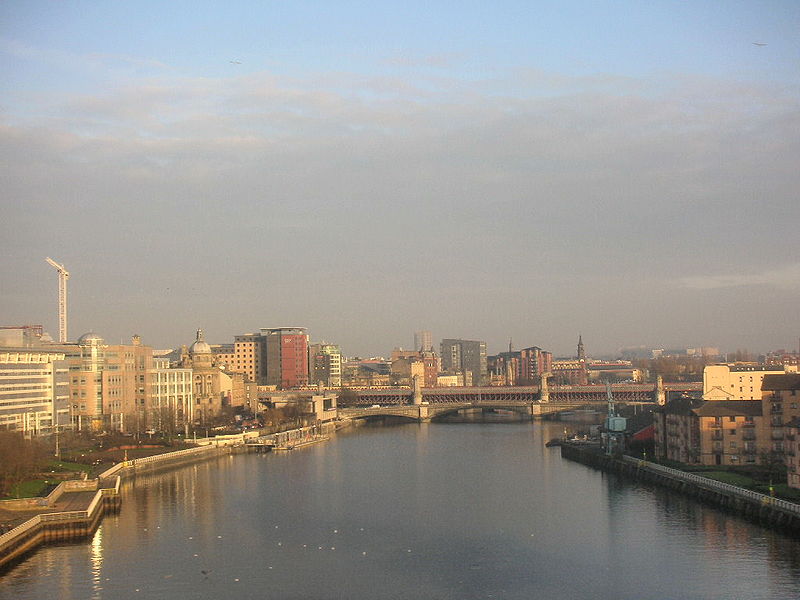 When the war ended he again took up, as did certain other British neo-romantic artists of the time, his visionary preoccupations — in Spencer's case with a sometimes apocalyptic tinge.
When the war ended he again took up, as did certain other British neo-romantic artists of the time, his visionary preoccupations — in Spencer's case with a sometimes apocalyptic tinge.
 on theClyde.
on theClyde.  When the war ended he again took up, as did certain other British neo-romantic artists of the time, his visionary preoccupations — in Spencer's case with a sometimes apocalyptic tinge.
When the war ended he again took up, as did certain other British neo-romantic artists of the time, his visionary preoccupations — in Spencer's case with a sometimes apocalyptic tinge.After getting Stanley's money as well as his house, she threw him out. Now poor and alone, Spencer thought he and Hilda should reunite. Hilda thought not. That private drama became public theatre in 1996, when Stanley, a pretty good play by Pam Gems, with Antony Sher in the main role, ran successfully in London and New York. At one point, Gems has Stanley trying to explain, in his halting way, how he would like his relations with women to work: "I'd like 20 wives ... I want to be able to go from one house to another ... be made welcome ... you feel more alive ..." He also says that this is what all men want. Only he is honest about it and of course hes right.In his time of intense agony, around 1936 and 1937, Spencer made what now look like his most powerful paintings, a series of hyper-realist nudes of Patricia. In their merciless power (no sag unnoticed, no blue vein unrecorded), they anticipate by some decades the grotesque nudes that have made Lucian Freud a commanding figure in contemporary art. Half a century ago, Spencer seemed old-fashioned; today, art has caught up with him. It no longer seems outlandish to call him the most important British painter of the last century.
Spencer has been the subject of several biographies. The diminutive survivor of turmoil domestic and military is depicted in his later years as a "small man with twinkling eyes and shaggy grey hair, often wearing his pyjamas under his suit if it was cold." He became a "familiar sight, wandering the lanes of Cookham  pushing the old pram in which he carried his canvas and easel." The pram, black and battered, has somehow survived, to become the most curious exhibit in the Stanley Spencer Gallery in Cookham, which is dedicated to its owner's life and works.In 1925, Spencer married Hilda Carline,
pushing the old pram in which he carried his canvas and easel." The pram, black and battered, has somehow survived, to become the most curious exhibit in the Stanley Spencer Gallery in Cookham, which is dedicated to its owner's life and works.In 1925, Spencer married Hilda Carline,  then a student at the Slade and sister of the artist Richard Carline.
then a student at the Slade and sister of the artist Richard Carline.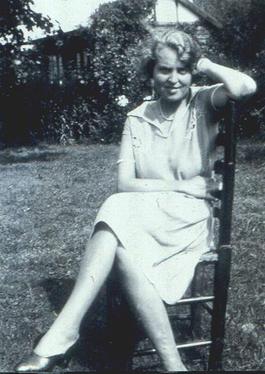 Spencer met the artist Patricia Preece in 1929 in Cookham.
Spencer met the artist Patricia Preece in 1929 in Cookham.  Hilda's refusal to accede to demands for a ménage à trois demanded by Spencer forced her eventually to file for a divorce which was granted on 25th May 1937. He became infatuated with her. Carline divorced Spencer in 1937.
Hilda's refusal to accede to demands for a ménage à trois demanded by Spencer forced her eventually to file for a divorce which was granted on 25th May 1937. He became infatuated with her. Carline divorced Spencer in 1937. 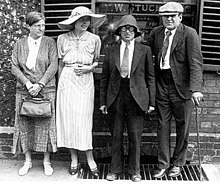 A week later he married Preece, who persuaded him to sign over his house to her; she, however, was a lesbian. She continued to live with her partner, Dorothy Hepworth,
A week later he married Preece, who persuaded him to sign over his house to her; she, however, was a lesbian. She continued to live with her partner, Dorothy Hepworth,  and though she (Dorothy is on the left ,Preece right)frequently posed nude for her husband,
and though she (Dorothy is on the left ,Preece right)frequently posed nude for her husband,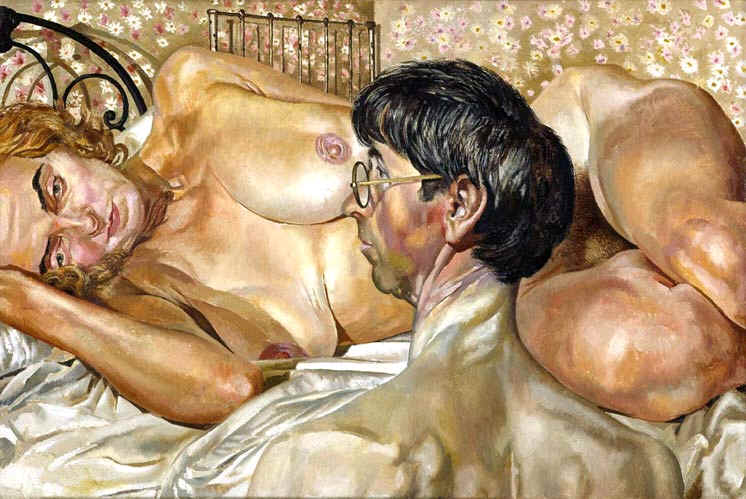 she refused to consummate the marriage.according to Tee A. Corinne: "Spencer went into debt giving Preece money, clothing, and jewelry... When Spencer married Preece, attempted to consummate the marriage, Preece immediately fled to Hepworth. Although Spencer and Preece never lived together as man and wife, they never divorced." Although the marriage was unconsummated, it did produce some remarkable nude portraits including Nude: Patricia Preece (1935),
she refused to consummate the marriage.according to Tee A. Corinne: "Spencer went into debt giving Preece money, clothing, and jewelry... When Spencer married Preece, attempted to consummate the marriage, Preece immediately fled to Hepworth. Although Spencer and Preece never lived together as man and wife, they never divorced." Although the marriage was unconsummated, it did produce some remarkable nude portraits including Nude: Patricia Preece (1935),+1935.jpg) Self Portrait with Patricia Preece (1936)
Self Portrait with Patricia Preece (1936)  and Double Nude Portrait: the Artist and his Second Wife (1937). When Spencer’s bizarre relationship with Preece finally fell apart (though she would never grant a divorce), he would visit Hilda, an arrangement that continued throughout the latter's subsequent mental breakdown.
and Double Nude Portrait: the Artist and his Second Wife (1937). When Spencer’s bizarre relationship with Preece finally fell apart (though she would never grant a divorce), he would visit Hilda, an arrangement that continued throughout the latter's subsequent mental breakdown. Spencer continued to paint pictures of his marriage to Hilda Carline. This included Domestic Scenes: At the Chest of Draws (1936), The Beatitudes of Love (1937) and Romantic Meeting (1938). He also wrote her many letters but following a mental breakdown she was admitted to Banstead Mental Hospital in Epsom. Spencer gave his house in Cookham to Patricia Preece 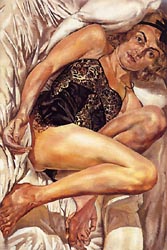 who rented it out in 1938, and he was forced to move to a rented room in Adelaide Road, Hampstead.
who rented it out in 1938, and he was forced to move to a rented room in Adelaide Road, Hampstead. Over the next few years he produced a series of paintings entitled Christ in the Wilderness (1939–53).
Over the next few years he produced a series of paintings entitled Christ in the Wilderness (1939–53).
 who rented it out in 1938, and he was forced to move to a rented room in Adelaide Road, Hampstead.
who rented it out in 1938, and he was forced to move to a rented room in Adelaide Road, Hampstead. Over the next few years he produced a series of paintings entitled Christ in the Wilderness (1939–53).
Over the next few years he produced a series of paintings entitled Christ in the Wilderness (1939–53). Hilda died from cancer in November 1950.The painful intricacies of this three-way relationship became the subject in 1996 of a play by the feminist playwright Pam Gems. Titled Stanley, it starred Anthony  Sher, at the National Theatre and, later, on Broadway. Nominated for a Tony Award, it won the Olivier Best New Play award for 1997.
Sher, at the National Theatre and, later, on Broadway. Nominated for a Tony Award, it won the Olivier Best New Play award for 1997.
 Sher, at the National Theatre and, later, on Broadway. Nominated for a Tony Award, it won the Olivier Best New Play award for 1997.
Sher, at the National Theatre and, later, on Broadway. Nominated for a Tony Award, it won the Olivier Best New Play award for 1997.When a member of a British Council delegation to China not long before his death, Spencer is said to have introduced himself to Premier Zhou Enlai
British Council delegation to China not long before his death, Spencer is said to have introduced himself to Premier Zhou Enlai  with the words, "Hello, I'm Stanley from Cookham."
with the words, "Hello, I'm Stanley from Cookham."
 British Council delegation to China not long before his death, Spencer is said to have introduced himself to Premier Zhou Enlai
British Council delegation to China not long before his death, Spencer is said to have introduced himself to Premier Zhou Enlai  with the words, "Hello, I'm Stanley from Cookham."
with the words, "Hello, I'm Stanley from Cookham."Spencer was knighted in 1959. He died of cancer at nearby Cliveden later that year.

 Spencer's early work is regarded as a synthesis of French Post-Impressionism, exemplified for instance byPaul Gauguin, plus early Italian painting typified by Giotto. This was a conscious choice, and Spencer was a key member of a group who called themselves the "Neo-Primitives."
Spencer's early work is regarded as a synthesis of French Post-Impressionism, exemplified for instance byPaul Gauguin, plus early Italian painting typified by Giotto. This was a conscious choice, and Spencer was a key member of a group who called themselves the "Neo-Primitives." 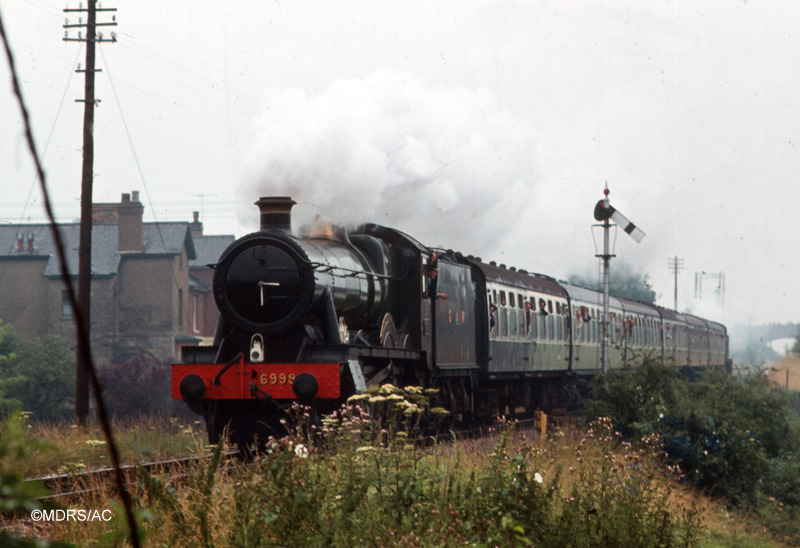 Allied with him were David Bomberg, William Roberts and other young contemporaries at the Slade.Spencer has been described as an early modernist painter. His works often express his fervent if unconventional Christian faith.
Allied with him were David Bomberg, William Roberts and other young contemporaries at the Slade.Spencer has been described as an early modernist painter. His works often express his fervent if unconventional Christian faith.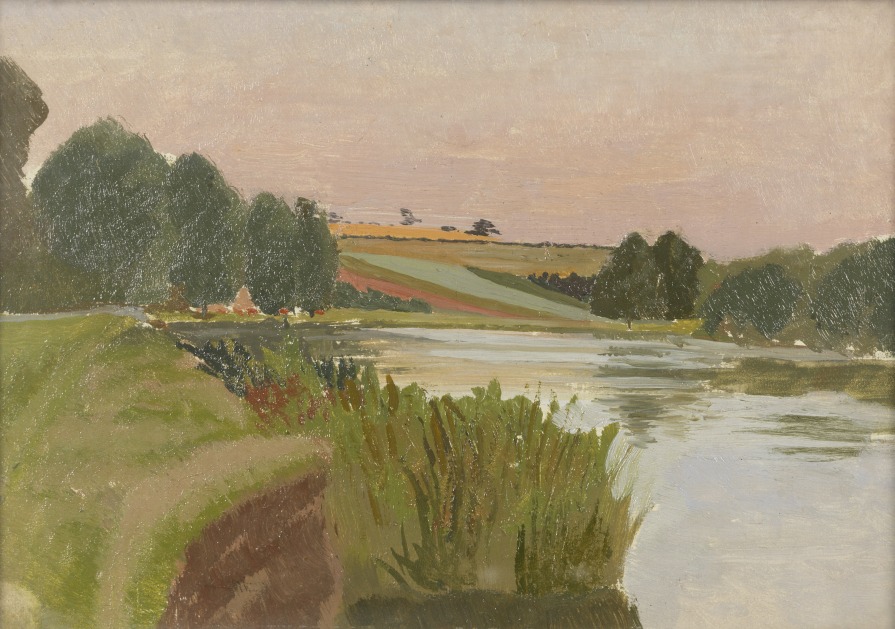 This is especially evident in the scenes that he envisioned and depicted in Cookham. Very evident in these too is the compassion that he felt for his fellow
This is especially evident in the scenes that he envisioned and depicted in Cookham. Very evident in these too is the compassion that he felt for his fellow  residents. His quirky romantic and sexual obsessions were also expressed within this home environment, but it is a mistake to regard him merely as some sort of quaint village innocent, inextricably tied to small-town England. His works originally provoked great shock and controversy.
residents. His quirky romantic and sexual obsessions were also expressed within this home environment, but it is a mistake to regard him merely as some sort of quaint village innocent, inextricably tied to small-town England. His works originally provoked great shock and controversy.  Nowadays, they still seem stylistic and experimental, whilst the nudes that arose through the futile relationship with Patricia Preece, such as the Leg of mutton nude, foreshadow some of the much later works of Lucian Freud, who expressed admiration for Spencer.
Nowadays, they still seem stylistic and experimental, whilst the nudes that arose through the futile relationship with Patricia Preece, such as the Leg of mutton nude, foreshadow some of the much later works of Lucian Freud, who expressed admiration for Spencer.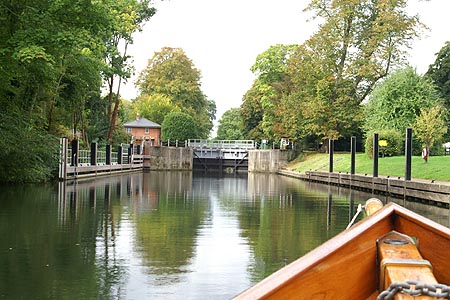
His most ambitious work was the consequence of his Great War experiences: a cycle of 19 wall paintings for the Sandham Memorial Chapel , which took five years to complete. During the Second World War, he was recruited by the War Artists' Advisory Committee to help in the war effort by recording activities that were taking place on the home front. Spencer chose to paint Clyde shipbuilders at work; when the war ended, he was in the process of planning a three-tier frieze 70 feet long representing their work.[8]

Today, works such as The Resurrection, Cookham (1923–27), clearly set in the village and with actual residents taking part, rarely come up for auction, but when they do, they sell for immense sums. However, during Spencer's lifetime, it was his landscapes that were in demand. His dealer would press him to produce more, but Spencer expressed impatience, and professed that they were a chore. Nevertheless these landscapes of Cookham and its environs are still favored by many of the public

Spencer made only three lithographs, all under the guidance of Henry Trivic ]In November 2006, the Imperial War Museum asked Manchester United manager Sir Alex Ferguson to lead a campaign to fund restoration of  Spencer's paintings of Port Glasgow's shipyards in wartime and certain other works. Ferguson, whose father, brother and an uncle were working in the yards while the artist was there, took up the challenge.
Spencer's paintings of Port Glasgow's shipyards in wartime and certain other works. Ferguson, whose father, brother and an uncle were working in the yards while the artist was there, took up the challenge.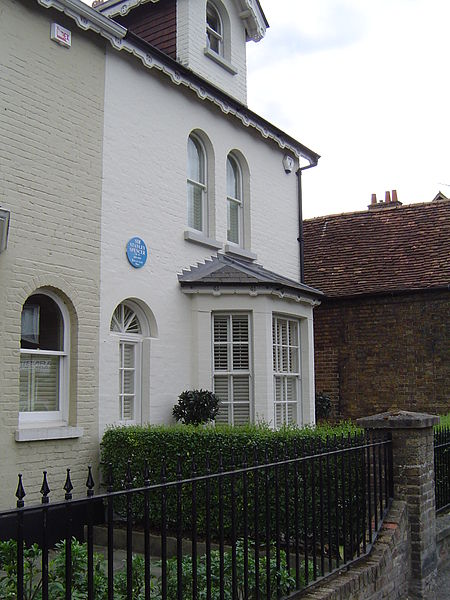
 Spencer's paintings of Port Glasgow's shipyards in wartime and certain other works. Ferguson, whose father, brother and an uncle were working in the yards while the artist was there, took up the challenge.
Spencer's paintings of Port Glasgow's shipyards in wartime and certain other works. Ferguson, whose father, brother and an uncle were working in the yards while the artist was there, took up the challenge.
Spencer's house near Cookham Rise Primary school is still in private occupation. The village's Methodist Chapel where the artist worshipped is today the Stanley Spencer Gallery. It mounts two exhibitions a year and holds over 100 items of his works

Spencer was cremated and his ashes laid in Cookham Churchyard, beside the path through to Bellrope Meadow. A discreet marble memorial marks the spot. His daughters, Unity and Shirin, now in their seventies, told a journalist a couple of years ago that in retrospect they bear their father no ill will. Unity said: "I suppose I felt that he was honest about what had happened.
His daughters, Unity and Shirin, now in their seventies, told a journalist a couple of years ago that in retrospect they bear their father no ill will. Unity said: "I suppose I felt that he was honest about what had happened. I felt that he had taken himself to task over it. And that meant a lot to me." One day he said to her: "Oh, if only I hadn't made that mistake! We could have been a happy family."
I felt that he had taken himself to task over it. And that meant a lot to me." One day he said to her: "Oh, if only I hadn't made that mistake! We could have been a happy family."
 His daughters, Unity and Shirin, now in their seventies, told a journalist a couple of years ago that in retrospect they bear their father no ill will. Unity said: "I suppose I felt that he was honest about what had happened.
His daughters, Unity and Shirin, now in their seventies, told a journalist a couple of years ago that in retrospect they bear their father no ill will. Unity said: "I suppose I felt that he was honest about what had happened. I felt that he had taken himself to task over it. And that meant a lot to me." One day he said to her: "Oh, if only I hadn't made that mistake! We could have been a happy family."
I felt that he had taken himself to task over it. And that meant a lot to me." One day he said to her: "Oh, if only I hadn't made that mistake! We could have been a happy family."
Hilda's mental health suffered and in the 1940s she spent nine months in a psychiatric hospital, where Stanley often visited her and then as stated she died of cancer in 1950. That year he made a painting, Love Letters, perhaps the most touching in the exhibition. It shows the two of them in a huge chair that dwarfs them and makes them look like children; they are reading letters they have written each other. After Hilda's death, Stanley continued to paint her, and in the year of his own death he was still writing letters to her.
That year he made a painting, Love Letters, perhaps the most touching in the exhibition. It shows the two of them in a huge chair that dwarfs them and makes them look like children; they are reading letters they have written each other. After Hilda's death, Stanley continued to paint her, and in the year of his own death he was still writing letters to her. Listen, flowers, birds, winds, worlds,
Listen, flowers, birds, winds, worlds,
tell all today that I married That year he made a painting, Love Letters, perhaps the most touching in the exhibition. It shows the two of them in a huge chair that dwarfs them and makes them look like children; they are reading letters they have written each other. After Hilda's death, Stanley continued to paint her, and in the year of his own death he was still writing letters to her.
That year he made a painting, Love Letters, perhaps the most touching in the exhibition. It shows the two of them in a huge chair that dwarfs them and makes them look like children; they are reading letters they have written each other. After Hilda's death, Stanley continued to paint her, and in the year of his own death he was still writing letters to her. Listen, flowers, birds, winds, worlds,
Listen, flowers, birds, winds, worlds,more than a white girl in the barley -
for today I took to my human bed
flower and bird and wind and world, and all the living and all the dead.
No comments:
Post a Comment